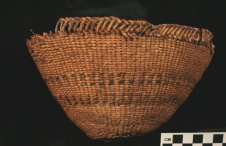Great Basin Prehistoric Footwear
In Nevada, people have been making woven sandals and leather moccasins for the last 10,000 years. Prehistoric footwear, however, is relatively rare. Among the historic tribes in Nevada (Washoe, Western Shoshone, Northern Paiute, Southern Paiute), people preferred to go barefoot as much as possible. Yet each group used footwear, when needed, for protection from cold, wet, hot, muddy, or rocky conditions.
The best sandal record comes from Western Nevada. The oldest sandals, known as Fort Rock Type sandals, have been found in southwestern Oregon and at Elephant Mountain Cave in the Black Rock Desert. These sandals are made from sagebrush bark and date between 10,500 and 9,200 years ago. Other types from southwestern Oregon and Western Nevada include Multiple Warp sandals made from sagebrush bark or tule and dating from about 9,000 years ago to historic times, and Spiral Weft sandals made from sagebrush bark or tule. While the age distribution for Spiral Weft sandals is not definitive, half of the approximated dates fall between 7,000 and 9,000 years ago, with the other half dated less than 2000 years ago.
Caves near Lovelock contain sandals that are not like others from the region. These tule sandals are known as V-Twined-Bag-type sandals, as they are made in the same way as woven bags. One of these sandals has been dated to between AD 1650 and AD 1880, but the complete potential age range for these types of sandals is unknown.
Prehistoric moccasins are not as well understood as sandals and consistent typologies have not been developed. The discoveries of prehistoric moccasins have been scant: the 10,000-year-old skeleton from the burial in Spirit Cave, near Fallon, was wearing moccasins; a pair of moccasins from Elephant Mountain Cave has been dated at 1,700 years old; and moccasins were also found in Lovelock Cave. Superficial analysis of these artifacts suggests that they are not similar in construction. This is not surprising, as Fremont peoples in Eastern Nevada also made and used moccasins that were different from those found in Western Nevada.
The moccasins and sandals discovered show that the materials, construction, and design are not at all similar to those found in Southern Nevada. In this respect, the study of these prehistoric artifacts has illuminated a clear boundary marker between the Great Basin and the Southwest culture areas.
Article Locations
Related Articles
Further Reading
None at this time.

